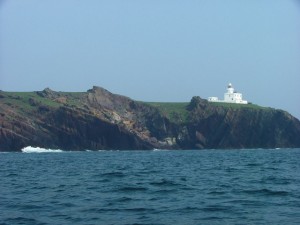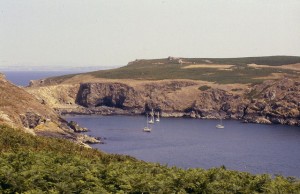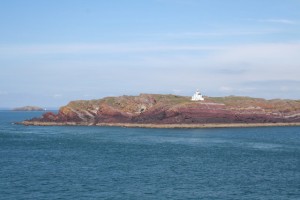Across the world, islands that were once privately-owned are being put into public hands; this month in Wales, a conservation group is aiming to complete their purchase of a beautiful wildlife haven.
The steep, red-hued cliffs of Skokholm Island, surrounded by the cold waters of Jack Sound, lead up to a sprawling 265-acre island of remarkable beauty and history. In 1933, the island, found three miles from the southwestern Welsh coast of Pembrokeshire, became the first official bird observatory in Britain, and remains one of its most important today. Storm petrels, buzzards, puffins, and gulls of all stripes use the island as a way station or nesting ground, leading to a plethora of information about the migratory and breeding habits of dozens of species, including some threatened populations.
The island is currently owned – almost in entirety – by the Wales Wildlife Trust (WWT), a non-profit organization dedicated to nature conservation. Both Skokholm and the neighbouring larger island of Skomer, also owned by the WWT, are home to one of the largest populations of Manx Shearwaters in the world, a small puffin that takes its name both from the Isle of Man, and the distinctive flight pattern that appears like the low-flying birds are “shearing” the water with their long wingtips. The area of the island where these birds are concentrated, however, is not yet under the WWT’s ownership.
The majority of the island, with the exception of the lighthouse and surrounding cliffs, was purchased by the WWT in April of 2006, following a highly successful public fundraising effort with support from numerous other conservation groups. The group’s history with the island goes quite a bit further back than that, however – it has been leased and managed by the WWT since 1948 through an arrangement with the former owners, the Dale Castle Estate, who were in possession of Skokholm for 350 years. Further back, the Scandinavian-sounding island was indeed named by the Norse, meaning “wooded island” in their ancient language.
Currently considered a “Site of Special Interest” and part of the Skomer and Skokholm Protection Area, the organization has campaigned for the government to further solidify the islands’ protected status with a formal designation as a National Nature Reserve. The WWT, who are bidding £250,000 for the lighthouse estate, Currently, the lighthouse is owned by Trinity House, who the WWT would seek to maintain the light’s operation should they successfully purchase the land.
The WWT’s chairman Professor Lynda Warren was quoted in a local paper as saying that; “Trinity House and the Wildlife Trust of South and West Wales have been excellent neighbours for many years and the importance to conservation of the land surrounding the lighthouse meant that we were naturally interested in buying this and the lighthouse itself.”
The lighthouse estate dates from just 1916, but other sites on the island have a remarkably ancient provenance, including Bronze Age ruins. The predecessor to the current lighthouse was first built in 1776 to guide ships through the dangerous waters of Jack Sound – not always successfully, however. The area, while not technically a Marine Protected Zone, is home to numerous shipwrecks of historical significance, including one which lies just offshore of Skokholm. It would behoove both the government and interested citizens to support any efforts to preserve this gorgeous isle, both for the current bird populations, and our long-gone ancestors who left their mark.
Read the original article: Wales Online





